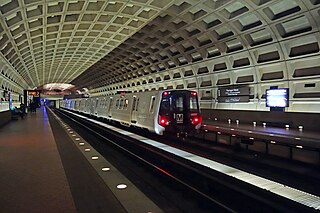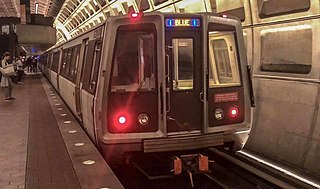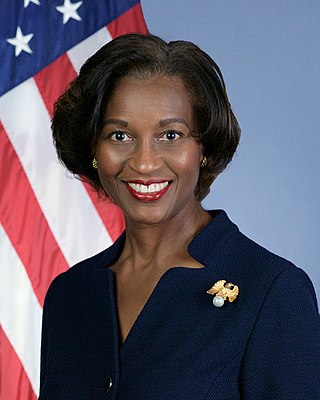Related Research Articles

The Washington Metro, often abbreviated as the Metro and formally the Metrorail, is a rapid transit system serving the Washington metropolitan area of the United States. It is administered by the Washington Metropolitan Area Transit Authority (WMATA), which also operates the Metrobus service under the Metro name. Opened in 1976, the network now includes six lines, 98 stations, and 129 miles (208 km) of route.

The Blue Line is a rapid transit line of the Washington Metro system, consisting of 28 stations in Fairfax County, Alexandria and Arlington, Virginia; Washington, D.C.; and Prince George's County, Maryland, United States. The Blue Line runs from Franconia–Springfield to Largo. The line shares track with the Orange Line for 13 stations, the Silver Line for 18, and the Yellow Line for six on the same segment and seven altogether. Only three stations are exclusive to the Blue Line.

The Red Line is a rapid transit line of the Washington Metro system, consisting of 27 stations in Montgomery County, Maryland, and Washington, D.C., in the United States. It is a primary line through downtown Washington and the oldest and busiest line in the system. It forms a long, narrow "U," capped by its terminal stations at Shady Grove and Glenmont.

The Yellow Line is a rapid transit line of the Washington Metro system that runs between Huntington in Virginia and Mount Vernon Square in Washington, D.C. It consists of 13 stations in Fairfax County, the city of Alexandria, and Arlington County in Virginia, and Washington, D.C. It is the shortest line in the system, and since its truncation to Mount Vernon Square, it is the only line that does not enter Maryland.

Shady Grove station is a Washington Metro station in Redland, Maryland, United States. The station opened on December 15, 1984 as part of a four-stop extension of the Red Line from Grosvenor–Strathmore station to Shady Grove. The station is operated by the Washington Metropolitan Area Transit Authority (WMATA).

Huntington station is an island-platformed Washington Metro station in the Huntington area of Fairfax County, Virginia, United States. The station was opened on December 17, 1983, and is operated by the Washington Metropolitan Area Transit Authority (WMATA). Serving as the southern terminus for the Yellow Line, the station is built into a hillside; the south mezzanine, along with escalator access, is accessible via an incline elevator.

Navy Yard–Ballpark station is a Washington Metro station in Washington, D.C., on the Green Line. The station is located in the Navy Yard/Near Southeast neighborhood of Southeast, with entrances on M Street at Half Street and New Jersey Avenue.

The Washington Metropolitan Area Transit Authority, commonly referred to as Metro, is a tri-jurisdictional public transit agency operates transit service in the Washington metropolitan area. WMATA provides rapid transit service under the Metrorail name, fixed-route bus service under the Metrobus brand, and paratransit service under the MetroAccess brand. In 2023, the system had a ridership of 239,741,800, or about 975,800 per weekday as of the second quarter of 2024.

David L. Gunn is a transportation system administrator who has headed several significant railroads and transit systems in North America. He was director of operations of the Massachusetts Bay Transportation Authority (MBTA) from 1975 to 1979, general manager and chief operations officer of SEPTA from 1979 to 1984, president of the New York City Transit Authority from 1984 to 1990, the general manager at WMATA from 1991 to 1994, and chief general manager of the Toronto Transit Commission in Canada from 1995 to 1999. Gunn assumed the presidency of Amtrak on May 15, 2002, and held the position until political upheaval at the company in 2005. A dual citizen of the U.S. and Canada, Gunn retired to his family home on Cape Breton Island in Nova Scotia, Canada. He is currently associated with the Free Congress Foundation and the board of the Strait Area Transit Cooperative transit service in rural Richmond County, among other roles.
Richard A. White is an American public transportation official who served as the CEO and General Manager of the Washington Metropolitan Area Transit Authority during 1996–2006. Prior to joining WMATA as CEO, he served as the general manager at Bay Area Rapid Transit in the San Francisco area. White also spent six years with the federal Urban Mass Transit Administration, which is now the Federal Transit Administration. White is from Massachusetts.
The rolling stock of the Washington Metro system consists of 1,242 75-foot (22.86 m) cars that were acquired across seven orders. All cars operate as married pairs, with systems shared across the pair. The 7000-series cars, the system's newest, have an operator's cab in only one of each married pair's cars and operate in groups of three or four.

Metrobus is a bus service operated by the Washington Metropolitan Area Transit Authority (WMATA). Its fleet consists of 1,595 buses covering an area of 1,500 square miles (3,900 km2) in Washington, D.C., Maryland, and Virginia. There are 269 bus routes serving 11,129 stops, including 2,554 bus shelters. In 2023, the system had a ridership of 103,438,600, or about 399,500 per weekday as of the second quarter of 2024.

The Silver Line is a rapid transit line of the Washington Metro system, consisting of 34 stations in Loudoun County, Fairfax County and Arlington County, Virginia, Washington, D.C., and Prince George's County, Maryland. The Silver Line runs from Ashburn in Virginia to Downtown Largo in Maryland. Five stations, from both lines' eastern terminus at Downtown Largo to Benning Road, are shared with the Blue Line alone; thirteen stations, from Stadium–Armory to Rosslyn, with both the Orange Line and Blue Lines; and five stations from Court House to East Falls Church with the Orange Line alone. Only the five stations of Phase 1, which began service on July 26, 2014, and the six stations of Phase 2, which began service on November 15, 2022, are exclusive to the Silver Line.

The Metro Transit Police Department (MTPD) is the transit police agency of the Washington Metropolitan Area Transit Authority (WMATA), created by the WMATA Compact on June 4, 1976.

During the afternoon rush hour of June 22, 2009, a subway train wreck occurred between two southbound Red Line Washington Metro trains in Northeast, Washington, D.C., United States. A moving train collided with a train stopped ahead of it; the train operator along with eight passengers died, and 80 people were injured, making it the deadliest crash in the history of the Washington Metro.

There have been numerous incidents on the Washington Metro over its history, including several collisions causing injuries and fatalities, and numerous derailments. The Washington Metropolitan Area Transit Authority (WMATA) has been criticized for disregarding safety warnings and advice from experts.

The Northern Virginia Transportation Commission (NVTC) is an independent agency in the Commonwealth of Virginia to promote and improve transportation. It covers the Counties of Arlington, Fairfax, Loudoun, and the Cities of Alexandria, Falls Church, and Fairfax. NVTC manages the Northern Virginia Transportation District. That District was created by the 1964 Acts of Assembly of the Commonwealth of Virginia, chapter 630; and the Transportation District Act.

Andrew Byford is a British transport executive who has held several management-level positions in transport authorities around the world, such as the Toronto Transit Commission (TTC), New York City's Metropolitan Transportation Authority (MTA), Transport for London (TfL), Sydney's then RailCorp, and currently Amtrak.

Nuria I. Fernandez is a civil engineer who served as the administrator of the Federal Transit Administration (FTA), from June 10, 2021 to February 24, 2024. After she was appointed as deputy administrator of the FTA on January 21, 2021, she served as the acting administrator until her confirmation in June. Fernandez has held leadership positions in large transit agencies, including as general manager and chief executive officer of the Santa Clara Valley Transportation Authority from 2014 to 2021, chief operating officer of the Metropolitan Transportation Authority (MTA) from 2011 to 2014, and senior vice president of design and construction for both the Chicago Transit Authority (CTA) and Washington Metropolitan Area Transit Authority (WMATA) from 1994 to 1997.
References
- ↑ "Veteran Transit Executive John B. Catoe, Jr. appointed Metro's next general manager" (Press release). Washington Metropolitan Area Transit Authority. 2007-01-25. Archived from the original on 2011-06-15. Retrieved 2009-09-26.
- ↑ Sun, Lena (2006-11-14). "Metro Picks L.A. Official, D.C. Native As Manager". The Washington Post. Retrieved 2009-09-26.
- ↑ Sun, Lena H.; Hohmann, James (2009-09-25). "Catoe's Contract Renewed In Show of Broad Support". The Washington Post. Retrieved 2009-09-26.
- ↑ "Metro GM Catoe announces resignation". WTOP. 2010-01-14. Retrieved 2010-01-14.